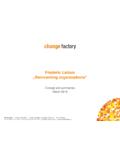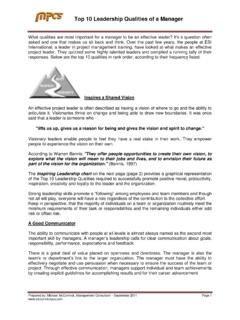Transcription of Frederic Laloux - REINVENTING ORGANIZATIONS - Home
1 Ulrich Gerndt | change factory GmbH | Im Alten Fruchthof | Gotzinger Stra e 52b | 81371 M nchen Fon +49 (0) 89 / 76 73 66 - 0 | Fax +49 (0) 89 / 76 73 66 - 100 | | Frederic Laloux REINVENTING ORGANIZATIONS - Excerpt and summaries - March 2014 Frederic Laloux (content based on his book REINVENTING ORGANIZATIONS (2014) 2 Frederic Laloux REINVENTING ORGANIZATIONS Frederic Laloux (content based on his book REINVENTING ORGANIZATIONS (2014) 3 Background Modern ORGANIZATIONS have brought about sensational progress for humanity in less than two centuries the blink of an eye in the overall timeline of our species. None of the recent advances in human history would have been possible without ORGANIZATIONS as vehicles for human collaboration. And yet, many people sense that the current way we run ORGANIZATIONS has been stretched to its limits.))
2 We are increasingly disillusioned by organizational life. For people who toil away at the bottom of the pyramids, surveys consistently report that work is more often than not dread and drudgery, not passion or purpose. That the Dilbert cartoons could become cultural icons says much about the extent to which ORGANIZATIONS can make work miserable and pointless. Life at the top of the pyramids isn t much more fulfilling. Behind the fa ade and the bravado, the lives of powerful corporate leaders are ones of quiet suffering too. Their frantic activity is often a poor cover up for a deep inner sense of emptiness. The power games, the politics, and the infighting end up taking their toll on everybody. At both the top and bottom, ORGANIZATIONS are more often than not playfields for unfulfilling pursuits of our egos, inhospitable to the deeper yearnings of our souls Could it be that our current worldview limits the way we think about ORGANIZATIONS ?
3 Could we invent a more powerful, more soulful, more meaningful way to work together, if only we change our belief system? Frederic Laloux (content based on his book REINVENTING ORGANIZATIONS (2014) 4 The basic question What do ORGANIZATIONS molded around the next stage of consciousness look and feel like? Is it already possible to describe their structures, practices, processes, and cultures (in other words, to conceptualize the organizational model) in useful detail, to help other people set up similar ORGANIZATIONS ? Can we create ORGANIZATIONS free of the pathologies that show up all too often in the workplace? Free of politics, bureaucracy, and infighting; free of stress and burnout; free of resignation, resentment, and apathy; free of the posturing at the top and the drudgery at the bottom?)
4 Is it possible to reinvent ORGANIZATIONS , to devise a new model that makes work productive, fulfilling, and meaningful? Can we create soulful workplaces schools, hospitals, businesses, and nonprofits where our talents can blossom and our callings can be honored? ? ? Frederic Laloux (content based on his book REINVENTING ORGANIZATIONS (2014) 5 The greatest danger in times of turbulence is not the turbulence It is to act with yesterday s logic. Peter Drucker Frederic Laloux (content based on his book REINVENTING ORGANIZATIONS (2014) 6 Human development happens in stages, along various lines How has humanity evolved from the earliest forms of human consciousness to the complex consciousness of modern times? How do we human beings evolve today from the comparatively simple form of consciousness we have at birth to the full extent of adult maturity?))
5 Example dimensions: needs (Maslow) worldviews (Gebser) cognitive capacities (Piaget), values (Graves), Humanity evolves in stages. We are not like trees that grow continuously. We evolve by sudden transformations, like a caterpillar that becomes a butterfly, or a tadpole a frog. moral development (Kohlberg, Gilligan), self-identity (Loevinger), spirituality (Fowler), leadership (Cook-Greuter, Kegan, Torbert), Frederic Laloux (content based on his book REINVENTING ORGANIZATIONS (2014) 7 The evolution of consciousness is accelerating ever faster When we plot the successive stages of human and organizational consciousness on a timeline, the result is striking. Evolution seems to be accelerating, and accelerating ever faster. Never before in human history have we had people operating from so many different paradigms all living alongside each other.)
6 The same is true for ORGANIZATIONS : in the same city, if we care to look, we can find Red, Amber, Orange, and Green ORGANIZATIONS working side by side. Frederic Laloux (content based on his book REINVENTING ORGANIZATIONS (2014) 8 With each level of development, everything changes, including organizational models Every transition to a new stage of consciousness has ushered in a whole new era in human history. At every juncture, everything changed: society (going from family bands to tribes to empires to nation states); the economy (from foraging to horticulture, agriculture, and industrialization); the power structures; the role of religion. One aspect hasn t yet received much attention: with every new stage in human consciousness also came a break-through in our ability to collaborate, bringing about a new organizational model.)
7 ORGANIZATIONS as we know them today are simply the expression of our current world-view, our current stage of development. Frederic Laloux (content based on his book REINVENTING ORGANIZATIONS (2014) 9 Human development Overview of the main (organizational) paradigms Levels of Consciousness TURQUOISE TEAL GREEN ORANGE AMBER RED MAGENTA INFRARED foraging bands authority by the Elders powerful chiefdoms formal hierarchies command & control the stick effective matrix, predict & control, the carrot , shareholder perspective relationships above outcomes, stakeholder perspective self manage-ment for evolutionary purpose 100 000 yrs ago 100 00 yrs ago 1000 yrs ago 100 yrs ago 10 yrs ago 1 yr ago Frederic Laloux (content based on his book REINVENTING ORGANIZATIONS (2014) 10 There is nothing inherently better about being at a higher level of development, just as an adolescent is not better than a toddler.))
8 However, the fact remains that an adolescent is able to do more, because he or she can think in more sophisticated ways than a toddler. Any level of development is okay; the question is whether that level of development is a good fit for the task at hand. Nick Petrie (Center for Creative leadership ) On human development Frederic Laloux (content based on his book REINVENTING ORGANIZATIONS (2014) 11 (Impulsive) RED ORGANIZATIONS Metaphor: WOLFPACK CHARACTERISTICS Constant exercise of power by chief to keep troops in line. Fear is the glue of the organization. Highly reactive, short term focus. Thrives in chaotic environments. EXAMPLES Mafia Streetgangs Tribal militias leadership STYLE predatory KEY BREAKTROUGHS Division of labor Command authority Frederic Laloux (content based on his book REINVENTING ORGANIZATIONS (2014) 12 (Conformist) AMBER ORGANIZATIONS Metaphor: ARMY CHARACTERISTICS Highly formal roles within a hierarchical pyramid.))
9 Top down command and control (what and how). Stability valued above all through rigorous processes. Future is repetition of the past. EXAMPLES Catholic church Military Most government agencies Public school systems leadership STYLE paternalistic-authoritative KEY BREAKTROUGHS Formal roles (stable and scalable hierarchies) Processes (long term perspectives) Frederic Laloux (content based on his book REINVENTING ORGANIZATIONS (2014) 13 (Achiever) ORANGE ORGANIZATIONS Metaphor: MACHINE CHARACTERISTICS Goal is to beat competition; achieve profit and growth. Innovation is the key to staying ahead. Management by objectives (command and control on what; freedom on the how). EXAMPLES Multinational companies Charter schools leadership STYLE goal- and task-oriented, decisive KEY BREAKTROUGHS Innovation Accountability Meritocracy Frederic Laloux (content based on his book REINVENTING ORGANIZATIONS (2014) 14 (Pluralistic) GREEN ORGANIZATIONS Metaphor: FAMILY CHARACTERISTICS Within the classic pyramid structure, focus on culture and empowerment to achieve extraordinary employee motivation.))
10 EXAMPLES Culture driven ORGANIZATIONS ( Southwest Airlines; Ben&Jerry s ..) leadership STYLE consensus oriented, participative, service KEY BREAKTROUGHS Empowerment Values-driven culture Stakeholder model Frederic Laloux (content based on his book REINVENTING ORGANIZATIONS (2014) 15 (Evolutionary) TEAL ORGANIZATIONS Metaphor: LIVING ORGANISM CHARACTERISTICS Self-management replaces hierarchical pyramid. Organization is seen as a living entity, with its own creative potential and evolutionary purpose. EXAMPLES Patagonia FAVI Buurtzorg leadership STYLE distributed leadership , with inner rightness and purpose as primary motivator and yardstick KEY BREAKTROUGHS Self management Wholeness Evolutionary purpose Frederic Laloux (content based on his book REINVENTING ORGANIZATIONS (2014) 16 Every challenge you encounter in life is a fork in the road.))


